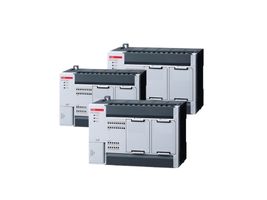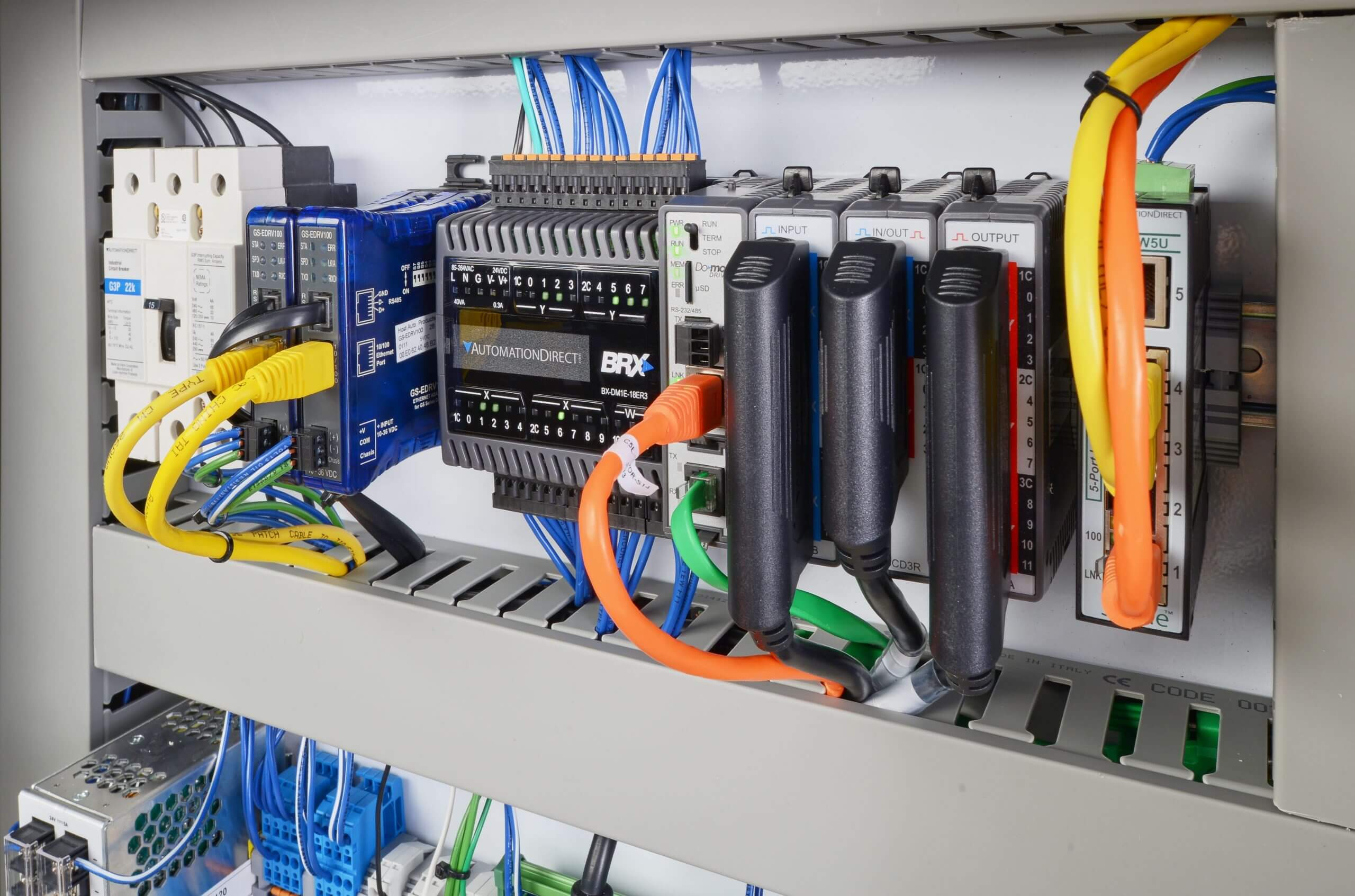Introduction to PLC
A PLC (Programmable Logic Controller) is a programmable control device widely used in industrial automation. With the ability to replace traditional relay systems, PLCs enhance efficiency, reduce operating costs, and increase flexibility in production. PLCs can be programmed to perform a variety of tasks, ranging from simple operations such as turning devices on/off to complex control systems.
Compared to traditional relay systems, PLCs offer many advantages, including:
- High flexibility: The program can be easily changed without modifying hardware.
- High reliability: PLCs operate stably in harsh industrial environments.
- Expandability: Can connect to multiple peripheral devices.
- Integrated communication: Supports multiple communication protocols such as Modbus, Profibus, and Ethernet/IP for easy system integration.

Operating Principles
A PLC operates in a continuous loop consisting of three main steps: reading input signals, processing logic, and outputting signals. This process occurs in real-time, allowing the system to quickly respond to input signals.
1. Reading Input Signals
A PLC receives signals from sensors, switches, or other systems. These signals can be in digital or analog form:
- Digital Input (DI): ON/OFF signals such as switches, push buttons, and photoelectric sensors.
- Analog Input (AI): Continuous data such as temperature, pressure, and flow measured by corresponding sensors.
2. Signal Processing
The PLC’s central processing unit (CPU) performs calculations, comparisons, and executes control programs based on pre-programmed algorithms. The PLC memory stores control programs and the status of devices.
PLCs can perform various control tasks such as:
- Basic logic control: AND, OR, NOT, XOR operations.
- Sequential control: Executing steps in a predetermined sequence.
- Analog signal processing: Controlling motor speed, temperature, and pressure.
- Communication processing: Connecting with SCADA, DCS, and IoT systems.
3. Outputting Signals
After processing, the controls actuators such as motors, valves, conveyors, or other automated systems based on calculated output signals.
- Digital Output (DO): Controls ON/OFF devices such as relays and indicator lights.
- Analog Output (AO): Controls motor speed, and adjusts valve opening levels.
4. Communication with Other Devices
PLCs can connect with HMI (Human-Machine Interface), SCADA (Supervisory Control and Data Acquisition), or manufacturing management systems to monitor and control the entire production process. Additionally, PLCs can integrate with energy management and smart factory systems.
5. Scan Cycle Mechanism
A PLC continuously performs the read – process – output cycle at high speed (measured in milliseconds), ensuring precise and timely system responses. This cycle includes:
- Reading data from inputs.
- Executing the pre-programmed control logic.
- Updating output statuses.
- Repeating the entire process.
Applications in Industry
PLCs play a vital role across various industries, providing advanced automation, precise control, and seamless integration with industrial processes. Their flexible programming, high reliability, and ability to operate in demanding environments make them essential for improving efficiency, safety, and productivity in manufacturing, energy, healthcare, and many other sectors.
1. Manufacturing Automation
Automation systems manage assembly lines, conveyors, and industrial robots to ensure precise coordination between machines. This enhances productivity, reduces human errors, and allows seamless operation with minimal manual intervention, improving overall production quality.
2. Food and Beverage Industry
Automated control systems regulate ingredient mixing, temperature settings, and packaging processes, ensuring that products meet strict quality and food safety standards. These solutions also help optimize production speed, maintain hygiene, and reduce material waste.
3. Textile Industry
In textile production, automation ensures precise operation of weaving machines, fabric cutting systems, and dyeing processes. By adjusting speed and material handling automatically, these systems improve fabric quality, reduce defects, and increase manufacturing efficiency.
4. Power and Energy Industry
Automation technology is essential for managing power grids, optimizing energy distribution, and controlling substations. Intelligent monitoring helps detect faults, balance loads, and ensure stable electricity supply for both industrial and residential needs.
5. Chemical Industry
Automated systems oversee chemical reaction processes, regulate dosing systems, and monitor critical parameters such as temperature and pressure. This enhances precision in chemical mixing, ensures safety compliance, and prevents hazardous incidents.
6. Water Treatment Systems
Advanced control solutions regulate pumps, valves, filtration systems, and water quality sensors in treatment plants. These technologies help optimize resource usage, maintain purification efficiency, and ensure compliance with environmental standards.
7. Automotive Industry
Automation plays a vital role in vehicle manufacturing, from robotic welding and painting to quality inspection and component assembly. These technologies enhance precision, improve consistency, and reduce overall production time.
8. Healthcare Industry
In medical facilities, automation supports laboratory analyzers, sterilization units, and hospital monitoring systems. These solutions improve accuracy, reliability, and efficiency in medical diagnostics and treatment processes.
9. Construction Industry
Smart building automation systems manage elevators, fire protection mechanisms, lighting, and security features. These technologies enhance safety, energy efficiency, and operational convenience in modern infrastructure projects.
Conclusion
PLCs are an essential component of industrial automation, improving efficiency and precision in manufacturing. As technology advances, PLCs are increasingly being applied in various industries, from manufacturing to infrastructure management. If your business is looking for an automation solution, PLCs are an indispensable choice. Understanding how PLCs operate and their applications can help optimize production, reduce operating costs, and enhance efficiency.




